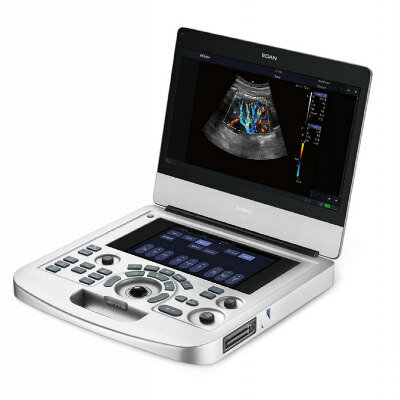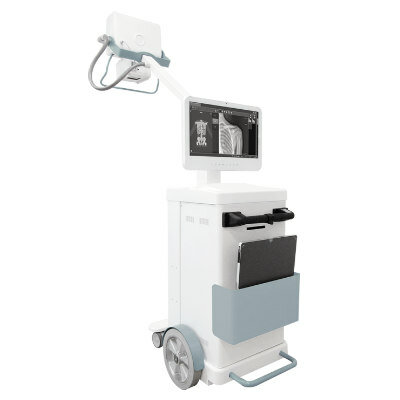Gantry-Free Cone-Beam CT Offers More Flexibility for Elbow Imaging
|
By MedImaging International staff writers Posted on 15 Dec 2023 |

Elbow injuries are frequently seen in emergency rooms, yet capturing high-quality images of such injuries can be challenging. Traditional CT systems typically have a gantry diameter of 70 to 80 cm, requiring patients to adopt a prone position with the injured arm extended, often referred to as a "superman" pose. This position, with the injured arm either beside the body or on the abdomen, can affect image quality as well as require increased radiation doses. An effective alternative has emerged in the form of gantry-free cone-beam CT (CBCT) combined with large flat-panel detectors. This approach has been shown to significantly reduce the radiation dose compared to traditional gantry-based multidetector CT (MDCT), without compromising image quality. Researchers recently undertook a study to evaluate the effectiveness of gantry-free CBCT compared to two-dimensional radiography in diagnosing acute elbow trauma in both adults and children.
In the study, conducted at University Hospital Würzburg (Würzburg, Germany), researchers used a high-resolution CBCT scanning mode based on a radiographic system equipped with two telescopic arms mounted on ceiling rails. These arms carry the X-ray tube and a large flat panel detector, respectively. Their coordinated movement along set trajectories facilitates the collection of three-dimensional projection data. The retrospective study revealed that, in 23 patients who had difficulty being positioned for gantry-based CT, elbow fractures were more sensitively diagnosed using gantry-free CBCT than with traditional two-dimensional radiography.
The CBCT system effectively overcomes the positioning challenges of gantry-based CT and yields remarkably high-quality images. Moreover, gantry-free CBCT offers enhanced dose efficiency due to the unique acquisition geometry of its twin robotic arms. Although the CBCT's acquisition time of 14 seconds is longer than the five seconds typical of gantry CT, leading to concerns about potential motion artifacts and reduced image quality, this issue was mitigated by allowing scanning of the elbow in a comfortable, flexed 90° position, minimizing patient movement. In related research, it was also demonstrated that imaging the appendicular skeleton with the gantry-free CBCT system is viable even in the presence of metal implants that can potentially impair image quality.
“Cross-sectional elbow imaging in the context of trauma can be quite challenging,” said Andreas Kunz, MD, a radiologist at the University Hospital Würzburg. “Not only did this CBCT system eliminate the positioning challenges associated with gantry-based CT, it also provided remarkably high-quality images.”
“The investigated gantry-free cone-beam CT promises to alleviate the most common challenges to imaging the appendicular skeleton without compromising image quality, radiation dose or patient comfort,” Dr. Kunz added.
Related Links:
University Hospital Würzburg
Latest General/Advanced Imaging News
- New AI Method Captures Uncertainty in Medical Images
- CT Coronary Angiography Reduces Need for Invasive Tests to Diagnose Coronary Artery Disease
- Novel Blood Test Could Reduce Need for PET Imaging of Patients with Alzheimer’s
- CT-Based Deep Learning Algorithm Accurately Differentiates Benign From Malignant Vertebral Fractures
- Minimally Invasive Procedure Could Help Patients Avoid Thyroid Surgery
- Self-Driving Mobile C-Arm Reduces Imaging Time during Surgery
- AR Application Turns Medical Scans Into Holograms for Assistance in Surgical Planning
- Imaging Technology Provides Ground-Breaking New Approach for Diagnosing and Treating Bowel Cancer
- CT Coronary Calcium Scoring Predicts Heart Attacks and Strokes
- AI Model Detects 90% of Lymphatic Cancer Cases from PET and CT Images
- Breakthrough Technology Revolutionizes Breast Imaging
- State-Of-The-Art System Enhances Accuracy of Image-Guided Diagnostic and Interventional Procedures
- Catheter-Based Device with New Cardiovascular Imaging Approach Offers Unprecedented View of Dangerous Plaques
- AI Model Draws Maps to Accurately Identify Tumors and Diseases in Medical Images
- AI-Enabled CT System Provides More Accurate and Reliable Imaging Results
- Routine Chest CT Exams Can Identify Patients at Risk for Cardiovascular Disease
Channels
Radiography
view channel
Novel Breast Imaging System Proves As Effective As Mammography
Breast cancer remains the most frequently diagnosed cancer among women. It is projected that one in eight women will be diagnosed with breast cancer during her lifetime, and one in 42 women who turn 50... Read more
AI Assistance Improves Breast-Cancer Screening by Reducing False Positives
Radiologists typically detect one case of cancer for every 200 mammograms reviewed. However, these evaluations often result in false positives, leading to unnecessary patient recalls for additional testing,... Read moreMRI
view channel
PET/MRI Improves Diagnostic Accuracy for Prostate Cancer Patients
The Prostate Imaging Reporting and Data System (PI-RADS) is a five-point scale to assess potential prostate cancer in MR images. PI-RADS category 3 which offers an unclear suggestion of clinically significant... Read more
Next Generation MR-Guided Focused Ultrasound Ushers In Future of Incisionless Neurosurgery
Essential tremor, often called familial, idiopathic, or benign tremor, leads to uncontrollable shaking that significantly affects a person’s life. When traditional medications do not alleviate symptoms,... Read more
Two-Part MRI Scan Detects Prostate Cancer More Quickly without Compromising Diagnostic Quality
Prostate cancer ranks as the most prevalent cancer among men. Over the last decade, the introduction of MRI scans has significantly transformed the diagnosis process, marking the most substantial advancement... Read moreUltrasound
view channel
Deep Learning Advances Super-Resolution Ultrasound Imaging
Ultrasound localization microscopy (ULM) is an advanced imaging technique that offers high-resolution visualization of microvascular structures. It employs microbubbles, FDA-approved contrast agents, injected... Read more
Novel Ultrasound-Launched Targeted Nanoparticle Eliminates Biofilm and Bacterial Infection
Biofilms, formed by bacteria aggregating into dense communities for protection against harsh environmental conditions, are a significant contributor to various infectious diseases. Biofilms frequently... Read moreNuclear Medicine
view channel
New SPECT/CT Technique Could Change Imaging Practices and Increase Patient Access
The development of lead-212 (212Pb)-PSMA–based targeted alpha therapy (TAT) is garnering significant interest in treating patients with metastatic castration-resistant prostate cancer. The imaging of 212Pb,... Read moreNew Radiotheranostic System Detects and Treats Ovarian Cancer Noninvasively
Ovarian cancer is the most lethal gynecological cancer, with less than a 30% five-year survival rate for those diagnosed in late stages. Despite surgery and platinum-based chemotherapy being the standard... Read more
AI System Automatically and Reliably Detects Cardiac Amyloidosis Using Scintigraphy Imaging
Cardiac amyloidosis, a condition characterized by the buildup of abnormal protein deposits (amyloids) in the heart muscle, severely affects heart function and can lead to heart failure or death without... Read moreImaging IT
view channel
New Google Cloud Medical Imaging Suite Makes Imaging Healthcare Data More Accessible
Medical imaging is a critical tool used to diagnose patients, and there are billions of medical images scanned globally each year. Imaging data accounts for about 90% of all healthcare data1 and, until... Read more
Global AI in Medical Diagnostics Market to Be Driven by Demand for Image Recognition in Radiology
The global artificial intelligence (AI) in medical diagnostics market is expanding with early disease detection being one of its key applications and image recognition becoming a compelling consumer proposition... Read moreIndustry News
view channel
Bayer and Google Partner on New AI Product for Radiologists
Medical imaging data comprises around 90% of all healthcare data, and it is a highly complex and rich clinical data modality and serves as a vital tool for diagnosing patients. Each year, billions of medical... Read more





















